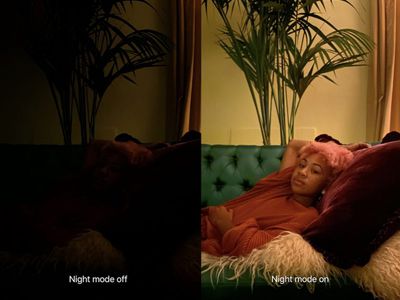Apple's iPhone 11 and iPhone 11 Pro models both feature upgraded camera systems with some impressive new capabilities, including a Night Mode that's designed to use Apple's machine learning and hardware to significantly improve photos captured in low light.
The feature, which is similar to the Google Pixel's Night Sight mode, was shown off by Apple on stage, but real-world photos have also surfaced today.

Canadian model and Nomad Management Modeling Agency founder Coco Rocha recently tweeted a night time shot that compares performance between the iPhone 11 and the iPhone X.
Don’t ask me how but I got my hands on the new iPhone 11 tonight! 🤫 Swipe through to see the difference between the 11 and the X in low light. 👀#notsponsored #butapplecansponsorme #callmypeople #timapple #iphone11promax #iphoneevent #iphone11 pic.twitter.com/wZHn6ugRQv — Coco Rocha (@cocorocha) September 12, 2019
The photos show a drastic difference, with the iPhone 11 shot preserving the full content of the image while the iPhone X produces a photo that's too dark to be usable.
The iPhone 11, iPhone 11 Pro, and iPhone 11 Pro Max all support Night Mode, which is designed to work without the flash to produce natural, bright photos in low light. A key component of the new Night Mode is the updated Wide camera sensor present in both iPhones.
Night Mode is activated automatically when it's needed, and Apple has outlined how it works. When you capture a Night Mode image, the camera takes multiple pictures in a row while utilizing optical image stabilization to steady the lens.
From there, the iPhone's software aligns images to correct for movement, discards sections with too much blur, and fuses sharper images together. Contrast is adjusted for balance purposes, and colors are fine-tuned to look natural. Noise reduction is employed and details are enhanced to produce the final images.
On Instagram, Apple has also been sharing photos that demonstrate the different camera modes available in the iPhone 11 Pro and Pro Max, both of which feature triple-lens camera setups.
These shots demonstrate the capabilities of the telephoto, wide, and ultra wide-angle lenses, with the latter lens being the new option.
The iPhone 11 has a dual-lens camera setup with a wide-angle and ultra wide-angle lens, so while it can do much of what the iPhone 11 Pro can do, it lacks the telephoto lens and the 2x optical zoom that comes with it.
All of the new iPhones support Portrait mode (and in the 11, you can take portraits of non-people, which wasn't possible with the XR), next-generation Smart HDR, Portrait Lighting, and will soon have a new Deep Fusion feature that Apple says will use pixel-by-pixel processing to optimize for texture, details, and noise.
The new iPhones will go on sale starting tomorrow, September 13, with pre-orders set to kick off at 5:00 a.m. Pacific Time. An official launch will follow on Friday, September 20.























